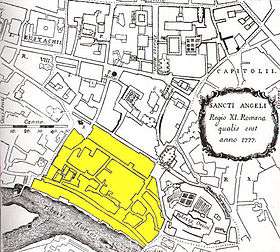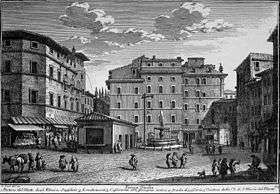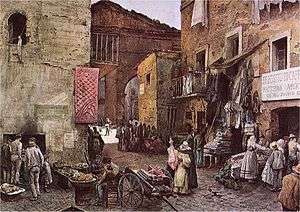Roman Ghetto
| Roman Ghetto | |
|---|---|
|
Native name Italian: Ghetto di Roma | |
|
Via Rua in Ghetto, (rione Sant'Angelo), by Ettore Roesler Franz (c. 1880) | |
| Coordinates | 41°53′33″N 12°28′39″E / 41.8924°N 12.4775°ECoordinates: 41°53′33″N 12°28′39″E / 41.8924°N 12.4775°E |
| Established | 1555 |
| Demolished | 1888 |
| Architect | Giovanni Sallustio Peruzzi |
The Roman Ghetto or Ghetto of Rome, Italian: Ghetto di Roma, was a Jewish ghetto established in 1555 in the Rione Sant'Angelo, in Rome, Italy, in the area surrounded by present-day Via del Portico d'Ottavia, Lungotevere dei Cenci, Via del Progresso and Via di Santa Maria del Pianto, close to the River Tiber and the Theatre of Marcellus. With the exception of brief periods under Napoleon from 1808 to 1815 and under the Roman Republics of 1798-99 and 1849, the ghetto of Rome was controlled by the papacy until the capture of Rome in 1870.[1]
Creation


The Roman Ghetto was established as a result of Papal bull Cum nimis absurdum, promulgated by Pope Paul IV on 14 July 1555. The bull also required the Jews of Rome, which had existed as a community since before Christian times and which numbered about 2,000 at the time, to live in the ghetto. The ghetto was a walled quarter with its gates locked at night. The wall was built under the direction of the architect Giovanni Sallustio Peruzzi. The cost of the wall's construction, 300 Roman scudi, had to be paid by the Jewish community. The area of Rome chosen for the ghetto was one of the most undesirable quarters of the city, subject to constant flooding by the Tiber River, but where Jews amounted already to 80% of the population.[2] At the time of its founding, the area was a trapezoid whose bases (parallel to the river) measured respectively 270 m (890 ft) (near the Tiber) and 180 m (590 ft), and whose sides was about 150 m (490 ft) long.[3] The wall started from Ponte Fabricio reaching the Portico d'Ottavia; from there it run along today's Via del Portico d'Ottavia (not including the ancient fish market (Italian: La Pescheria); at Piazza Giudea (which was cut in two) it bent again running along Vicolo Cenci (today Via del Progresso) until it reached the Tiber again.[2] The total area amounted to three hectares. At the time of Sixtus V (late 1580s), roughly 3,500 inhabitants were living in inhuman conditions.[3]
The bull also revoked all the rights of the Jewish community and imposed on Jews a variety of new restrictions such as prohibition on property ownership and practising medicine on Christians and compulsory Catholic sermons on the Jewish sabbath.
However, the ghetto was welcomed by some Jews who thought that its walls would protect the small Jewish community from possible attacks by Christian mobs and from the drain which must follow from assimilation, at the same time enabling Jewish religious customs to be observed without interference.
Jews were not allowed to own any property, even in the ghetto. Christian owners of houses in the ghetto could keep their property but, because of the jus gazzagà (right of possession) they could neither evict the Jews nor raise rents.[4]
Gates were added as the ghetto was successively enlarged.[3] Initially, there were two gates in the wall. The number increased to three in the 16th century and under Sixtus V to five, and finally, during the 19th century to eight. The gates were opened at dawn and closed every night, one hour after sunset between November and Easter, and two hours at other times.[3] The area contained hardly any noteworthy buildings. The only important square — Piazza Giudea[5] — was divided in two parts by the wall. All the churches which stood in the ghetto were deconsecrated and demolished soon after its construction.
In common with many other Italian ghettoes, the ghetto of Rome was not initially so called, but was variously referred to in documents as Italian: serraglio degli Ebrei or claustro degli Ebrei, both meaning "enclosure of the Hebrews". Various forms of the word ghetto came into use in the late 16th century. The modern Roman Jewish usage is ghétte.[6]
Life in the ghetto

Life in the Roman Ghetto was one of crushing poverty, due to the severe restrictions placed upon the occupations that Jews were allowed to perform. Roman Jews were allowed to work only at unskilled jobs, such as ragmen, secondhand dealers[7] or fish mongers. They were permitted to be pawnbrokers (which had been prohibited to Christians); and this activity excited the hatred of many Christians against them.
In the lottery game, they were allowed to bet only on low numbers (from 1 through 30), and all belonging to the same group of 10.[8] In case of a draw of five numbers of that kind, the Romans said that on that day in the ghetto there was taking place a great feast.[9]
When Jews went outside the ghetto, the men had to wear a yellow cloth (the "sciamanno"), and the women a yellow veil (the same color worn by prostitutes).[7] During the feasts they had to amuse the Christians, competing in humiliating games. They had to run naked, with a rope around the neck, or with their legs closed into sacks. Sometimes they were also ridden by soldiers.[10]
Jews had to petition annually for permission to live there. They paid a yearly tax for the privilege. Jews of Rome were required to swear yearly loyalty to the Pope at the Arch of Titus, which celebrates the Roman sack of Jerusalem of 70 CE. Each year, on the Campidoglio, the Rabbi had to pay homage to the chief of the city councillors ("Caporione"), receiving by him in exchange for it a kick to his bottom. This "ceremony" meant that the Jewish community had been allowed to stay one more year in Rome.[11]
Every Saturday, the Jewish community was forced to hear compulsory sermons[12] in front of the small church of San Gregorio a Ponte Quattro Capi, just outside the wall.[13]
At the time of its construction, in the ghetto – as almost everywhere in Rome – there was no fresh water. However, some years later the Popes built several fountains in the rione. One fountain, designed by Giacomo della Porta, was to be placed in the Piazza Giudea, the site of a market, inside the ghetto, but Muzio Mattei used his influence to have the fountain, the Fontana delle Tartarughe (Turtle Fountain) located in the Piazza Mattei, in front of his residence.[14][15][16]
As the Jewish community inside the ghetto grew, there was severe overcrowding. Since the area could not expand horizontally, the Jews built vertical additions to their houses, which blocked the sun from reaching the already dank and narrow streets.
The great number of people living in such a small area,[17] together with the poverty of the population, caused terrible hygienic conditions. The district, lying very low and near the Tiber, was often flooded. During the plague of 1656, 800 of 4,000 inhabitants died because of the epidemic.[3] Sant'Angelo, which was the rione with the smallest area, was also, because of the presence of the Ghetto, the one having the highest population density.
Abolition
When the Roman Republic was formed in 1798 and took over the Papal States, it annulled the requirement for Jews to live only in the ghetto; and a Tree of Liberty was planted in Piazza delle Cinque Scole ("Piazza of the Five Synagogues"). However, when the Papal States were restored in 1799, the ghetto was reestablished and Jews who had left were compelled to return to the ghetto.
On 17 April 1847 a group of young men from Trastevere broke open the gates of the Ghetto after they had been closed for the night.[18] In 1848, at the beginning of his pontificate, Pius IX permitted Jews to live outside the ghetto. However, after returning from exile in 1850, following the crushing of the Roman Republic, which made strong anti-Church measures,[19] the Pope issued a series of anti-liberal measures, including re-instituting the ghetto.[20] The Jewish head tax was abolished in 1850.
The Papal States ceased to exist on 20 September 1870 when they were incorporated in the Kingdom of Italy. With this the requirement that Jews live in the Ghetto came to an end. The ghetto walls were torn down in 1888 and the ghetto was almost completely demolished. On the resulting area the new Synagogue of Rome and apartment buildings were erected.
The Roman Ghetto was the last remaining ghetto in Western Europe until ghettos were reintroduced by Nazi Germany in the 1930s.
Legacy
Due to the three hundred plus years of isolation from the rest of the city, the Jews of the Roman Ghetto developed their own dialect, known as Giudeo-romanesco, which differs from the dialect of the rest of the city in its preservation of 16th-century dialectical forms and its liberal use of romanized Hebrew words.
Today, the district of the former Ghetto is the home of the Synagogue of Rome. There is one remaining piece of the Ghetto wall, which was built into the wall of one of the courtyards off the Piazza delle Cinque Scole.
See also
Sources
- Baronio, Cesare (1697). Descrizione di Roma moderna (in Italian). M. A. and P. A. De Rossi, Roma.
- About, Edmond (1861). Rome contemporaine (in French). Hetzel, Paris.
- Zanazzo, Giggi (1907–1910). Usi, costumi e pregiudizi del popolo di Roma (in Italian). Torino – Roma.
- Delli, Sergio (1975). Le strade di Roma (in Italian). Newton Compton, Roma.
- Pietrangeli, Carlo (1976). Sant'Angelo. Guide rionali di Roma. (in Italian). Fratelli Palombi, Roma.
- Staccioli, Romolo (1988). Roma entro le mura (in Italian). Fratelli Melita Roma.
- Agresti, Olivia Rossetti (1907). Giovanni Costa, his life, work, and times. 2nd edition London: Gay & Bird. (1st: London: Grant Richards, 1904)
- Debenedetti-Stow, Sandra (1992). "The Etymology of 'Ghetto': New Evidence from Rome". Jewish History 6(1/2), The Frank Talmage Memorial Volume: 79–85 (subscription required)
- Lerner, L. Scott. (Winter/Spring 2002) "Narrating Over the Ghetto of Rome", Jewish Social Studies 8(2/3) (New Series):1-38. doi 10.1353/jss.2002.0009. (subscription required)
- Stow, Kenneth R. Theater of Acculturation: The Roman Ghetto in the Sixteenth Century (Seattle: University of Washington Press, 2001). ISBN 978-0295980225
- Stow, Kenneth R. Jewish Life in Early Modern Rome: Challenge, Conversion, and Private Life (Aldershot, 2007). ISBN 9780754659167
References
- ↑ Lerner, 1.
- 1 2 Pietrangeli, 42.
- 1 2 3 4 5 Pietrangeli, 44.
- ↑ About, 96: Around 1860, rent for a large apartment in the ghetto was 30 scudi per month; the rent had remained the same since the reign of Urban VIII. The same apartment on the free market cost 450 scudi.
- ↑ Pietrangeli, 45: On the square were placed the barracks of the gendarmes which controlled the ghetto, and there was practiced the torment of the strappado ("la corda").
- ↑ Debenedetti-Stow, 79–85.
- 1 2 De Rossi, 222.
- ↑ This law was established because, since Jews had the reputation of being sorcerers, the Romans believed that they could win by witchcraft. Otherwise, usually the Italian lottery is played betting on up to five numbers ranging from 1 through 90. Zanazzo, 143.
- ↑ Zanazzo, 144.
- ↑ These habits were usual also before the erection of the Ghetto. For example, Pope Alexander VI was a fan of such competitions. He chose not to pave the new road named Borgo Nuovo, which he opened in 1500 in Borgo, in order to keep a better ground for the runners.
- ↑ This tradition was interrupted by Pius IX in 1847. About, 96.
- ↑ It is told that many Jews closed their ears with wax in order not to hear the sermon.
- ↑ On the façade of the church there is still an inscription of the prophet Isaiah (LXV, 2-3) in Hebrew and Latin, complaining about the stubbornness of the Jewish people.
- ↑ The fountain is now in Via del Progresso.
- ↑ The Waters of Rome, Morton (p.73-74)
- ↑ Fontaines de Rome, Maurizia Tazartes (p.62)
- ↑ The area of the Ghetto, after the enlargement under Sixtus V, was slightly larger than three Hectares. Pietrangeli, 44.
- ↑ Agresti, page 33
- ↑ Pougeois, Histoire de Pie IX, son pontificat et son siecle, Vol I-VI, Paris, 1877. Vol. II, p. 429.
- ↑ Pougeois, Vol. III, p. 258
Further references
- ^ Chadwick, Owen (1998). A History of the Popes 1830-1914. Oxford University Press. pp. 128–129. ISBN 0-19-826922-6.
- ^ Rome: A Let's Go City Guide, Matthew W. Mahan (editor), Macmillan, Cambridge, MA, 2004. ISBN 1-4050-3329-0, page 104.
- Debenedetti-Stow, Sandra (1992). "The Etymology of "Ghetto": New Evidence from Rome". Jewish History 6(1/2), The Frank Talmage Memorial Volume: 79-85 (subscription required)
External links
| Wikimedia Commons has media related to Ghetto (Roma). |
- Google Map: The Ghetto lies north of the Isola Tiberina, the white dome of the temple lies between Via Catalana and the river flanking, Lungotevere de' Cenci.
- October 18: Jews of Rome Deported to Auschwitz
- Liliana Picciotto Fargion. Il Libro della Memoria. Gli Ebrei deportati dall'Italia (1943-1945). Milan: Mursia, 1991 (in Italian)
- Entry in Romeartlover site
